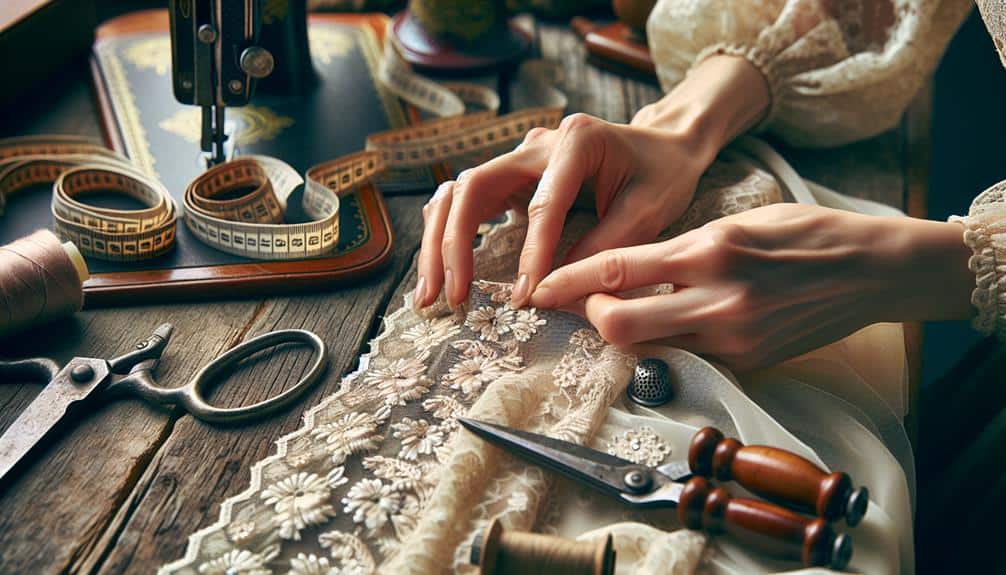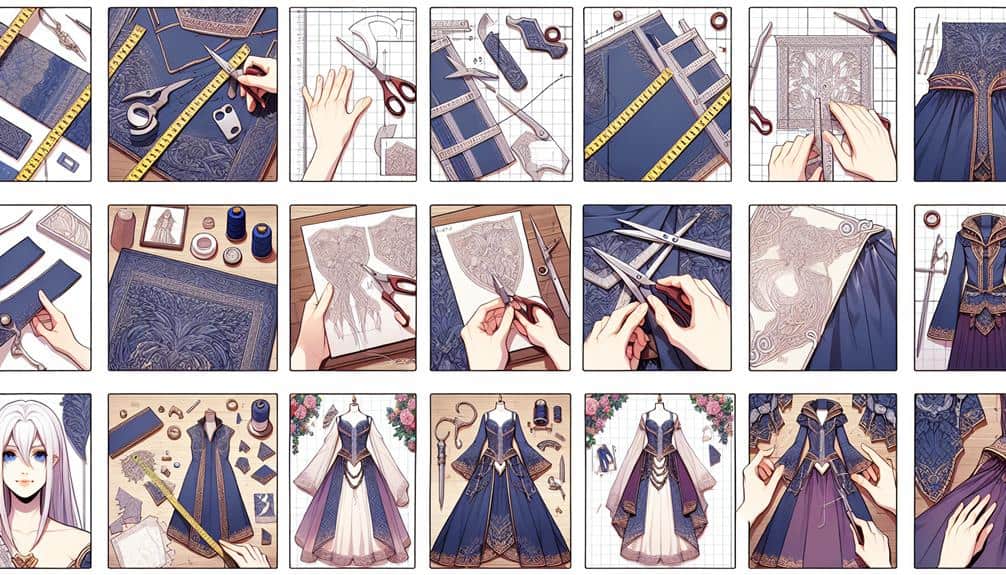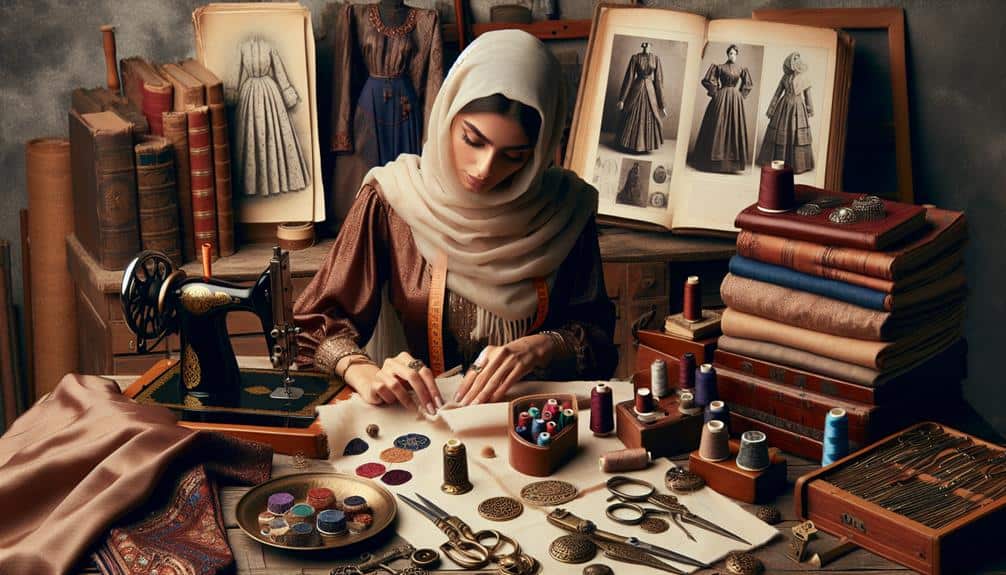Exploring to infuse your vintage cosplay costumes with authenticity and flair? Plunge into the world of classic sewing techniques that can elevate your creations to new heights.
From mastering the art of draping to incorporating intricate hand-sewing tricks, these seven best vintage cosplay costume sewing techniques are sure to level up your craftsmanship.
Explore how pattern alteration tips and vintage embellishment ideas can transform your costume-making process.
Stay tuned for insights on fabric selection guidance and authentic vintage reproduction methods that will bring a touch of nostalgia to your creations.
Key Takeaways
- Draping techniques for precise fitting and intricate details in vintage cosplay costumes.
- Authentic fabric selection and care for historical accuracy and durability.
- Attention to detail and historical context for authentic vintage reproduction methods.
- Experimenting with pleating styles, lace types, and fabric combinations for enhanced aesthetics.
Draping Techniques
To achieve the most accurate fit for your vintage cosplay costume, mastering draping techniques is essential. When it comes to creating authentic vintage looks, understanding different pleating styles is important. Knife pleats, box pleats, and accordion pleats can all be utilized to add intricate details to your costume. Knife pleats are sharp and narrow, while box pleats are wider and create a structured look. Accordion pleats offer a more flowing and delicate appearance. Experimenting with these pleating styles during the draping process will help you achieve the desired aesthetic for your costume.
Moreover, draping allows for precise fitting adjustments. By draping the fabric directly on a dress form or yourself, you can easily see where alterations are needed. Whether it's taking in the waist, adjusting the bustline, or adding more room in the hips, draping provides a hands-on approach to tailoring the costume to your specific measurements. Mastering draping techniques will elevate the authenticity and overall quality of your vintage cosplay costume.
Pattern Alteration Tips
Mastering pattern alteration tips is essential for achieving a perfectly tailored vintage cosplay costume that accurately reflects the era you're portraying. When delving into vintage fabric sourcing for your costume, ensuring the pattern fits your body perfectly is vital. Start by taking accurate body measurements and selecting a pattern size closest to your measurements.
To achieve a precise fit, consider making fitting adjustments such as grading between sizes, lengthening or shortening the pattern, or performing a full bust adjustment for a more accurate silhouette. Vintage patterns often require alterations due to changes in body shapes over the years, so be prepared to tweak the pattern to achieve an authentic vintage look.
Make muslins or mock-up garments to test the alterations before cutting into your final fabric. By meticulously adjusting the pattern to your measurements, you'll create a vintage cosplay costume that captures the essence of the era you wish to embody.
Fabric Selection Guidance
When selecting fabrics for your vintage cosplay costume, consider the historical accuracy of the era you're portraying to guarantee authenticity in your final creation. For color matching, research the popular colors and patterns of the time period. Opt for fabrics that were commonly used during that era, such as cotton, silk, wool, or linen, to make sure a genuine look. Additionally, pay attention to the texture and weight of the fabric to match the drape and silhouette of the historical garments.
Fabric care is important to maintaining the longevity of your vintage cosplay costume. Before sewing, always pre-wash your chosen fabric according to the manufacturer's instructions to prevent shrinkage or color bleeding. When handling delicate fabrics like silk, use a gentle hand wash or dry cleaning method to preserve the fabric's integrity. Avoid using harsh chemicals or high heat when caring for your costume to prevent damage or discoloration. By selecting appropriate fabrics and following proper care instructions, you can create a stunning vintage cosplay costume that's both accurate and durable.
Hand Sewing Tricks
When hand-sewing your vintage cosplay costume, paying attention to needle selection can make a significant difference in the final outcome.
Using a thimble not only protects your fingers but also helps maintain control over your stitches.
Understanding various stitching techniques can elevate the overall quality and durability of your handmade costume.
Needle Selection Tips
Selecting the right needle for your hand sewing project is essential for achieving precise stitches and ensuring the durability of your vintage cosplay costume. When choosing a needle, consider the fabric type and weight. For delicate fabrics like silk or satin, opt for a fine needle to prevent snags and runs. Conversely, heavier fabrics such as denim or canvas require a vital needle to pierce through without breaking.
Matching the needle size to the thread thickness is vital for maintaining proper thread tension, which affects the overall look and strength of your seams. Remember to change your needle regularly to avoid damage to the fabric and promote fabric care. By paying attention to these details, your hand-sewn vintage cosplay costume will stand the test of time.
Thimble Usage Benefits
To enhance your hand sewing techniques and protect your fingers, utilizing a thimble offers valuable benefits, especially when working on intricate vintage cosplay costumes. Thimbles provide essential finger protection by preventing needle pricks and potential injuries, allowing you to focus on your sewing accuracy without discomfort.
By using a thimble, you create a barrier between the needle and your skin, reducing the risk of painful punctures and ensuring a smoother sewing process. This tool promotes better control and precision, especially when dealing with delicate fabrics or intricate details.
Incorporating a thimble into your sewing routine not only safeguards your fingers but also contributes to the overall quality and efficiency of your vintage cosplay costume creations.
Stitching Technique Secrets
For achieving impeccable hand-sewn results in your vintage cosplay costume projects, mastering specific stitching techniques can greatly elevate the authenticity and intricacy of your creations.
When it comes to hand sewing tricks, incorporating embroidery techniques can add a touch of elegance and detail to your costume. Experimenting with different trim options like lace or velvet ribbon can enhance the vintage look you're aiming for.
Additionally, consider fabric distressing and weathering effects to give your costume a worn, authentic appearance. Techniques such as fraying edges, using sandpaper for a faded look, or strategically adding patches of discoloration can bring a unique dimension to your cosplay outfit.
These subtle details can make a significant difference in the overall vintage aesthetic of your costume.
Vintage Embellishment Ideas
Explore a myriad of intricate lace appliques and delicate beadwork to elevate the authenticity of your vintage cosplay costume. When looking for vintage accessory inspiration, consider popular embellishment trends from different eras. Reflecting on historical fashion details can provide valuable insights into the types of embellishments that were favored during specific time periods. By incorporating these elements into your costume construction techniques, you can create a truly authentic vintage look.
Vintage embellishments often feature intricate details such as hand-sewn lace appliques or carefully placed beadwork. Pay attention to the placement of these embellishments, as they can greatly impact the overall aesthetic of your costume. Researching historical fashion details can help you understand the significance of specific embellishments and how they were used in the past.
Experiment with different embellishment techniques to find the ones that best suit your vintage cosplay costume. Whether you're replicating a specific historical garment or creating a more fantastical interpretation, vintage embellishments can add a touch of authenticity and charm to your costume.
Hemming and Finishing Touches
When perfecting the hemming and finishing touches of your vintage cosplay costume, attention to detail is key in achieving an authentic and polished look. To elevate your costume to the next level, consider the following techniques:
- Vintage Lace: Adding vintage lace to the hems of your costume pieces can bring an elegant and timeless touch. Whether you choose delicate Chantilly lace or bold Guipure lace, this detail can enhance the overall aesthetic of your outfit.
- Pleating: Incorporating pleats into your costume design can create a sense of movement and dimension. Whether you opt for knife pleats, box pleats, or accordion pleats, this technique can add a sophisticated flair to your vintage look.
- Button Details: Paying attention to button details can make a significant difference in the overall appearance of your costume. Whether you choose ornate Victorian buttons or simple mother-of-pearl ones, these small accents can enhance the authenticity of your vintage ensemble.
Authentic Vintage Reproduction Methods
To truly capture the essence of a bygone era in your vintage cosplay costume, mastering authentic vintage reproduction methods is essential for achieving a historically accurate and visually stunning look.
When sourcing vintage fabric for your costume, it's important to research the time period you're aiming to recreate. Look for fabrics commonly used during that era, such as silk, wool, or cotton, and pay attention to patterns and colors popular at the time.
Authentic vintage detailing techniques play a significant role in bringing your costume to life. Techniques like hand-stitched embroidery, lace insertion, pintucks, and fabric manipulation can elevate the authenticity of your garment. Study vintage sewing patterns and tutorials to learn how these detailing techniques were traditionally executed.
Frequently Asked Questions
Can I Use Modern Sewing Machines for Vintage Cosplay Costume Sewing Techniques?
You can use modern sewing machines for vintage cosplay costume sewing techniques. While vintage machines have their charm, modern ones offer efficiency, diverse stitch options, and ease of maintenance. Experiment with retro sewing techniques using modern tools for a unique blend.
How Can I Properly Store and Care for Vintage Fabrics and Trims?
To properly care for vintage fabrics and trims, store them in a cool, dry place away from direct sunlight. Avoid folding them to prevent creases and use acid-free tissue paper when necessary. Regularly inspect for pests or damage.
Are There Any Specific Tips for Sewing Vintage-Inspired Accessories, Such as Hats or Gloves?
When sewing vintage-inspired accessories like hats or gloves, focus on intricate hat embellishments for a touch of elegance. Make precise glove construction with attention to seams and finishing. Embrace the charm of yesteryears through meticulous crafting techniques.
How Do I Create a Vintage Look While Still Incorporating Modern Elements Into My Cosplay Costume?
To create a vintage look while adding a modern flair to your cosplay costume, blend eras by mixing classic silhouettes with contemporary fabrics or accessories. Infuse cosplay creativity by incorporating subtle nods to modern trends within a retro aesthetic.
Are There Any Recommended Resources or Communities for Finding Vintage Sewing Patterns and Inspiration for Cosplay Costumes?
For vintage pattern hunting, explore online platforms like Etsy, eBay, and specialized vintage pattern shops. Join cosplay forums, Pinterest boards, and Instagram accounts for cosplay inspiration sources. Engage with fellow cosplayers to discover unique finds.


